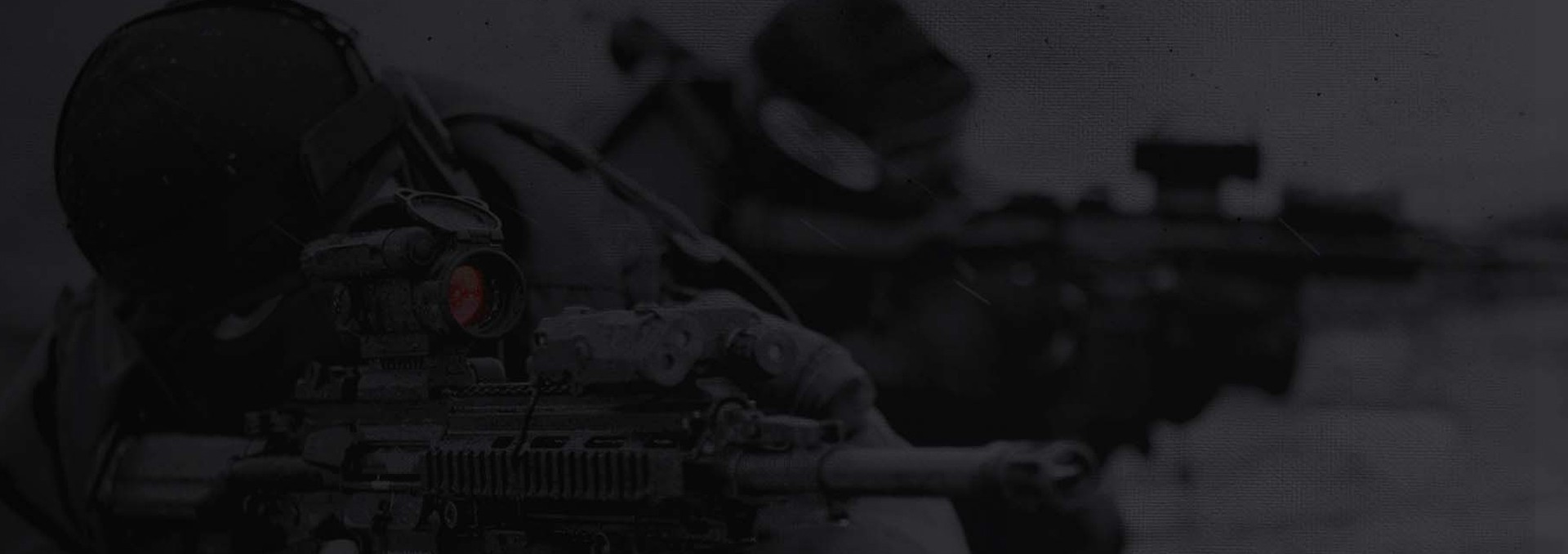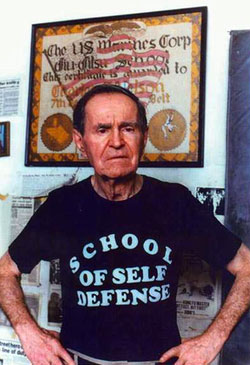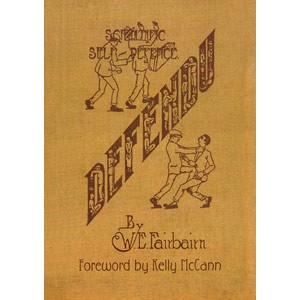Close Combat, Hand To Hand,
World War II, Self Defense
Mixed Martial Arts and Beyond
By Damian Ross
The Self Defense Company
Close combat or “Combatives” comes from the root word COMBAT – “to fight in direct contact”, “active fighting between enemies”, “any fight or struggle”.
What is the singular glaring absence in the above definition? Notice it? There is absolutely no mention of Fairbairn, Applegate, Biddle, World War II, Sykes, O’Neill or anyone else for that matter. Furthermore, there is no mention of any particular style, Jiu-Jitsu, Boxing, Savate or any member of the Gracie family. No mention of the Punic Wars or the Spartans. No mention of any techniques, Juji-Gatame, a smashing overhand right, an edge of hand blow, or even a good old kick in the ass!
What’s the point?!?
There are no specifics that define what is or isn’t so-called “Combatives”, Close Combat, Self Defense, Martial Arts, Hand to Hand or Whatever else people are calling it these days! So why do so many people feel such an overriding need to “define” combatives into a narrow scope of limited methodology?
Now anyone how thinks of world war II era hand to hand puts it into that “Fairbairn stuff”. A few months ago this same guy (or girl) thought Fairbairn was what you got when you had too much sun and Applegate was the entrance to an orchard!
Now everybody who is an “expert” in self defense is also and authority on combatives.
Well what exactly are you an expert at? I’m not sure even “they” really don’t even know.
This document won’t presume to speak for anyone else that uses this term “combatives”. Actually I wouldn’t want to! All it can do is offer a CORRECT semantic observation based on HISTORICAL FACT on what encompasses my study, training and understanding of so-called “combatives”.
The Roots of Close Combat, Self Defense and Mixed Martial Arts
If you really do your research you will see that even in manuals describing man to man combat that are centuries old, there exists a very comprehensive survey and presentations of many forms of armed and unarmed combat. You will find a vast array of weapon skills and “unarmed” combat that is a diverse mix of “techniques”.
Before the use of London Prize Ring rules and the Marquis of Queensbury, “pugilists” used and relied on a great number of different grappling, striking, kicking and gouging methods.
Ancient Greek Pankration was a combined system of “all powers” combat.
The original Koryu Bujutsu fighting systems of the Samurai included a comprehensive catalog of both armed and unarmed skills. The unarmed combatives of the Japanese Bushi also DIDN’T limit scope or method. Grappling was stressed when that was the best method of gaining tactical superiority. Striking, kicking and even biting was resorted to when that was deemed the most appropriate method.
The Chinese have always maintained fully robust systems of combat that included all manner of striking, punching, kicking, throwing, strangling and joint-locking.
Original Okinawan Te (Ti) included percussion methods as well as “tegumi” and “tuite”. Punch his lungs out if that did the job best. Kick his gonads out the top of his head if THAT worked best or grapple him into submission and control or grapple him into a spine lock and neck break.
No matter what culture or style, when it came to real fighting it was whatever was called for and whatever GOT THE JOB AT HAND DONE, PERIOD!
The 19th century saw many methods of “combined” self-defense systems develop in the West (READ: Mixed Martial Arts.)
The French combined elements of Chausson/Savate (Basque Zipota as well) with Boxe Anglaise, Parisian Lutte, and even the “new” Japanese Jiu-Jitsu.
The British did the same. The “BARTITSU” of Barton-Wright is a classic example. In the United States a number of self defense methods became available to the public that combined methods from Boxing and Wrestling. EVEN before any organized mixed martial arts systems were presented, men who fought even for sport used virtually ANY device to insure victory. Just read Elliot J. Gorn.
The Twentieth century saw even more “mixed” martial art combat systems. (It didn’t take a Sherlock Holmes to figure out that in a real fight ANYTHING goes.) Any and ALL manner of grappling, throttling, kicking, kneeing, butting, biting, punching, gouging, stomping and whatever other methods of mayhem could be employed were all “FAIR” when “fair” meant the difference between life or death and it certainly didn’t just end at “unarmed” fighting!
A gentleman of the day who beset upon by a rough and tumble “footpad” on a lonely and desolate backstreet would feel perfectly justified in running said “footpad” through and through again with his sword cane or bashing his brains in with a “lifesaver” even when the highwayman wasn’t even armed with a lowly brickbat. What’s that old saying? All’s fair in love and war. Often it’s not a matter of whose “right”, but simply whose LEFT!
This is the soul of combatives or self defense for self preservation is clear, pure and simple. Whatever WORKS BEST at the time! A mixture of varied fighting skills, a “mixed” fighting system, what a NOVEL IDEA!
Systematic Self Defense in the Industrial Age
The advent of World War I (the war to END all wars) brought warfare into a new and foreboding era of man to man killing and slaughter. Air power, mechanized warfare, chemical warfare and the general widespread use of machine guns changed the face of battle almost completely.
The static and stagnant lines created by entrenched warfare demanded new and innovative tactics and strategies. Among these was the advent of “raiding” parties.
Small groups of lightly armed men who ventured out into “no man’s land” behind enemy lines for the purpose of recon, probing, intelligence, prisoner grabs, and psychological demoralization missions. The nature of fighting under these conditions became popularized as trench warfare. This was close-in, knife to belly, hand to hand combat.
For this all manner of expedient, purpose designed and improvised close-combat weaponry was developed and deployed.
While technological advances were being made in all other forms of warfare, this particularly nasty and vicious man to man fighting reverted to the most barbaric, primitive and bloody “methods” imaginable. Despite these changes in technology, one solitary fact remained that in the end it was STILL man against man in a desperate, brutal and deadly struggle for survival. Just as it has been since Cain slew Abel and how it will be until the last two humans left on earth clench fists or seize stones in raging anger during the final melee of the Apocalypse. When it comes to hand to hand combat, NOTHING CHANGES!
Fostered by this fact, most military forces researched, developed and implemented fairly comprehensive and rigorous training methods specific to close-combat and trench fighting. The bayonet, the knife (especially the trench knife) and hand to hand combat became prime training doctrines along with advancements in general physical conditioning and battle preparation.
Unarmed hand to hand methods were drawn from any and ALL sources of man to man combat. Boxing, wrestling, savate, jiujitsu, and any number of rough and tumble, gouge and kick back alley tactics were employed. Those charged with the task of developing such training programs were well aware of the fact that no one single approach to combat was sufficient in real man to man kill or be killed battle!
Punching, kicking, striking, butting, stomping, biting, gouging, throwing, tripping, choking, strangling, bone breaking and the use of any and all weapons of close combat expediency were stressed!
The foregoing should satisfy and fulfill anyone’s definition of mixed martial arts tactics and techniques (even though Muay Thai or more accurately Siamese boxing and Brazilian Jiu-Jitsu were not included).
But to be fair, there are English language books circa the late 1920’s and 30’s that detail Siamese boxing quite well. One manual details the favorite attacks of Siamese style boxers as being directed at the liver with brutal kicks and at the throat while grasping the hair with one hand and smashing the throat with the other fist (gloves were NOT worn at this time). One should note: the liver attack was lethal in many cases because of the widespread epidemic of malaria which left the liver swollen and distended. Deaths occurred frequently in these matches and were considered just a routine hazard of the “trade”.
Proven Self Defense to the People
The years after WWI saw an increase in self defense “systems” designed for and marketed to the average citizen. Law Enforcement organizations also began to pay more attention to this area of training. This was part of a movement to increase the professionalism of law enforcement personnel in general. Virtually all of these systems advocated an all-around well-balanced approach to personal combat.
Elements of boxing, wrestling, foot-fighting and jiu-jitsu were put together in a toolbox of personal self defense tactics. The mixing of different martial art styles became quite popular. Even methods that relied primarily on western boxing and wrestling maneuvers acknowledged that a well rounded combatant must be able to both strike effectively as well as grapple.
Other methods of self defense touted “jiu-jitsu” as the singular answer to personal attack and defense. The reason is because most Japanese methods for self defense already included a comprehensive system of blows, strikes, kicks and grappling methods.
You should also know that it’s difficult to pin down a style of jiu-jitsu because during this period any method of Japanese self defense was given this moniker. Combine this with an influx of Japanese immigrants and emissaries promoting judo, their culture and the individual’s personal training and experience, it is impossible to determine a specific style or “ryu”. Add to that the Japanese effort to promote Judo above all of these methods, most of the older systems became outdated and lost. From the early 1900’s forward most English manuals and books refer to these systems as jiu-jitsu, jujutsu or judo.
It would be VERY good to remember here, that for all the “talk” about W.E. Fairbairn, during this period the Shanghai Municipal Police academy trained their recruits in boxing, wrestling and jiu-jitsu! One veteran of the Shanghai Municipal Police put it, “Our training in this area was a MIXED BAG of physical skills.”
There was virtually no “authority” or “expert” in this field who did not advocate a “MIX” of striking, kicking and grappling either as a combined “method” or as found singularly as in “real” Japanese jiu-jitsu.
When it was “for all the marbles” no one would be as short-sighted as to negate any and all possible methods of attack and defense. As far as reality training goes, jiu-jitsu (NOT Kodokan Judo) “free practice” or randori of this period allowed virtually anything. This included atemi (striking) to all kyusho (vital) points, including the testicles, base of skull etc. The only “advisement” was NOT to hit so HARD as to KILL your training partner, SAVE that for “matches” against OTHER jiu-jitsu schools!!!
Which Martial Art is the Best?
Only in the arena of sporting combat did this division of method, pitting one against another become a somewhat popular past time. Matching wrestlers against boxers, either of the two against jiu-jitsu men, or savate fighters against boxers (Biddle fought in such a match while in Paris). These matches were done under a constantly varying set of rules so that it became virtually impossible to ever really determine what “method” or martial art was superior. Even then, as some sportswriters of the time pointed out, what did ANY of this have to do with REAL fighting when NO rules applied?
Even the founder of Judo, Jigoro Kano’s nephew got involved in promoting these types of matches between western boxers and native Japanese Judoka. They were called “JU-KENTO”.“Ju” as in Judo and Jujutsu and “Kento”as in fist-fighting.
Even Choki Motobu when asked if his Kempo-Karate was “superior” to boxing (after his Knock Out of a western style pugilist) said that in order for his “method” to be used against a boxer specialized training specific for that type of match would have to be undertaken.
Judoka interested in these JU-KENTO bouts sought out specific instruction in just how to make Judo work against boxing. An entire book on this subject was published in Japan in the early 30’s. It is of the utmost importance to remember that all of these bouts had strict rules and regulations of engagement! Few if any of these mandates would have had much bearing on what one could do in a real pier-six back alley brawl. As an example: Judoka (Judo practitioners) were almost always forbidden to use any methods of atemi waza (striking, punching, kicking, butting and smashing). However, Judo experts of the time have advocated often and in their writings that atemi would be the MOST preferable method of attack and defense in a serious engagement.
The bottom line here is simply this: for use in a REAL violent assault NO ONE, but an utter FOOL, would suggest an attitude or method approaching anything LESS than that of an all-in, “anything goes” doctrine. In regards to deciding which martial art is best: NOTHING was ever, or could ever be, conclusively proven to be superior to anything else. At one time or another any of these various “methods” had both big and impressive WINS and equally impressive FAILURES.
The Question is: What makes effective Self Defense, Close Combat or Combatives? The point, I am sure, will be missed by some but it must be emphasized that these conclusions are based on historical fact and is accurate in substance and detail. This is an objective view of combatives and NOT a subjective opinion or personal “definition” designed to fill an agenda of one sort or another. The definition came first, the training came second!
Self Defense in the Modern Age
The Battle of Britain began in early July 1940. England was isolated, cut off and alone. The miracle retreat from Dunkirk and the German “Blitzkrieg” across Europe, including the crushing tactical defeat of the famed French “Maginot Line” proved the Third Reich war machine to be virtually unstoppable. Hitler’s plan for the invasion of England, named “Operation Sea Lion” was a daily focal point of danger and concern for the British.
Dunkirk had decimated the British forces and moral was at an all time low. Two recently returned veterans of British colonial rule in Shanghai, China approached the War Office and offered their services at this desperate time. William Ewart Fairbairn, retired as a ranking officer of the Shanghai Municipal Police force and his partner Eric Anthony Sykes, a private arms dealer who served as a volunteer in the Shanghai Municipal Police and where he headed the sniper unit of the famed Shanghai Riot Squad, promised the War Office that their training and methods could in short order make “any one man the equal of ten”.
After the debacle at Dunkirk this was a most important and dramatic statement. Initially dismissed, these two men went on to prove the veracity of their words and convinced the power that be as to absolute effectiveness of their methods. If that meant that an over middle aged W.E. Fairbairn had to place several young bucks in the hospital to prove his point in an impromptu, but extremely realistic “demonstration”, so be it. Those who “tested” Sykes fared NO better. So the methods that these men had developed during decades of very dangerous work in Shanghai now became a highly valued and integral part of training for all British forces and Special Operations personnel.
The attack on Pearl Harbor in December 1941 coupled with the Imperial Japanese military’s coordinated assault on all American and British forces across the Pacific Rim pulled the United States firmly in this world wide conflagration. The United States was now fully at war with the Axis forces. Fairbairn, who was now in Canada, assigned to the infamous “Camp X” where he along with “unarmed combat” George de Relwyskow, a BRAZILIAN JUDO/JUJUTSU EXPERT, and Colonel Carl Eifler was ALREADY undergoing training here, was ordered to assist the U.S. government agency known as the “The Office of the Coordinator of Intelligence” the precursor of the OSS.
Eric Anthony Sykes remained in England and found the need for his services in great demand. He also found himself working under the auspice of the British covert force known as the Special Operations Executive.
The history of these men from the early days of Shanghai, up to and through the war years is an entire story unto itself and beyond the scope of this article. However it must be clearly understood that the contribution of these men had a profound effect and influence on close-combat methods, tactics, and techniques for decades after the war (Despite the often heard “argument” that we have somehow “evolved” beyond these methods.) They were however, certainly not the only experts involved in this field! One of many examples would be A.J. Drexel-Biddle who studied and trained extensively in boxing, savate, jiu-jitsu, swordplay, knife-fighting and various bayonet methods.
As the United States geared up for war, a major factor began to be publicized. Both here and in Australia, the press made a great deal about the superiority of the Japanese fighting man. Part of this was, to be sure, rooted in fact.
The Battle of Port Arthur, the turning point in the Russo-Japanese war, several decades earlier, had shown the world the tenacity and ferocity of the Japanese soldier, particularly in the area of close-in man to man combat. Much was made of the large Russian soldier finding abject defeat at the hands of his smaller Japanese adversary when engaged in hand to hand combat (hence a very obvious need for the creation of Sambo). It was here that Japanese Jiu-jitsu was given world-wide attention and notoriety in this regard. The Japanese conduct and performance of the war in China also demonstrated to the world a seemingly invincible and unstoppable force. Japan was a force that was brutal and deadly in the extreme.
As a result, much attention was given over to the training of United States and Allied forces in methods of personal self defense that would enable the average soldier to meet the Japanese fighting man on a somewhat equal footing. Every branch of the Armed Services began an intensive physical training program designed to meet these needs. Much of the expert instruction needed, particularly in the arena of close-quarters man to man combat, came from the civilian quarter as it still does today.
Men with tremendous and varied life-long experience in all forms of martial arts and self defense were tapped to create training programs that would give the Allied soldier sufficient means by which to engage their enemies at close-quarters. The Axis did the same of course, Japan being the obvious factor in this regard, but even Adolf Hitler proclaimed the absolute need for boxing and jiu-jitsu in German military training as it imparted courage and daring the average soldier to close with his enemy!
In the United States there were a plethora of varied methods and training systems. Any attempt to narrowly define the methods extant in this era is complete ignorance and foolishness! Though the contribution of Lt. Colonel Fairbairn is great, as is the influence of Colonel Applegate, there were dznes upon dozens of different close-quarters battle systems developed. From wrestling, boxing, savate, judo, jiu-jitsu, Chinese boxing, and even football and rugby methods were not only drawn upon, but entire self defense systems were advocated based on these individual methods. It may come as a surprise to many, but here in the Unites States, even Japanese Karate was used and found to be effective!
The Development of a Fast and Effective Self Defense Training System
The same problems still exists today, many unarmed combat courses are highly complex and technical. They are rooted in the favored methods of the men tasked with their creation. Wrestlers tend to rely on that method, Judo and Brazilian Jujitsu men on that system, Boxers on their expertise and so on and so on. Each method also can claim stunning success in actual combat! True after action reports showed that ALL of these methods had merit and COULD be used effectively in the rigors and stress of real battle.
However, as the war progressed two major factors began to influence and change these training protocols. One was the fact that more and more men from all sorts of varied backgrounds being were drafted into military service, the other was that as demands for more and more replacement troops began to rise the amount of training time became by necessity reduced and limited.
The approach that seemed most feasible and useful was one that combined the best or the most effective, efficient and quickly learned methods as well as those most well RETAINED! The rudiment basics of boxing and wrestling were made part of an overall general physical conditioning program and unarmed combat became a specialized block of instruction.
These courses in unarmed combat, hand to hand combat, combat judo and so forth again sought to COMBINE the most advantageous holds, throws, trips, locks, strangles, blows, strikes and kicks from all the varied methods available. The only truly limiting factor here was the time element.
Other considerations were also important. The O’Neill (another Shanghai veteran and ranking Judo Black Belt) method is a classic example of a system specifically tailored for both the training environment available as well as the nature of the combat engagement expected. There were even attempts made to instruct the military in actual Koryu (old school) Jujutsu systems here in the United States, however the most effective systems still sought to mix all the varied martial arts.
As the war progressed, more and more after action intelligence gathered from the reality of actual battle helped shape and determine training priorities. Many methods of close-combat began to be trimmed down to those fundamentals that proved most effective overall and most applicable to all trainees across a wide and varied spectrum of physical attributes and skill.
Col. Rex Applegate was perhaps the most vocal of these advocates owing to his exposure in the INFANTRY JOURNAL and the publishing of “KILL or GET KILLED”. He was not without his critics, as was Fairbairn.
Some courses were so short in duration that they involved ONLY SEVERAL HOURS of instruction. Others were quite involved and very complete in their syllabus content. Many are familiar with the Navy V-5 programs and the training at Fort Benning, but lesser known is the very extensive training at places like Fort Meade and at the Hawaii Jungle Warfare complex. Here at these locations conducted a very complete and mixed program of martial arts was taught. From the CIC training center in Chicago to the Army training camps in Colorado, from Parris Island to the Ranger/Commando schools in the Hawaiian Islands, from the training bases in England prior to D-Day to the “Killing” school in Palestine, the METHODS taught ran the full gamut of man to man tooth and nail close quarters combat. From the complex to the “instinctive kill” (a method designed to take full advantage of so-called natural “animal” killing instinct). ALL these methods, systems and approaches FALL under the definition of COMBATIVES! Even the OSS personnel training at Area B were shown the methods of SIAMESE boxing (read Muay Thai), western boxing, wrestling/grappling, French “foot-fighting”(including Assaut Vite savate), Indian Varma-adi/Varmannie, Chinese boxing, “Roman” boxing, Japanese Judo/Jujutsu and Karate, Siamese boxing, Burmese boxing-Bando, western fencing, Filipino edged weapons and any and all systems (including almost every weapon known to man) deemed effective in dispatching one’s enemies to the hereafter were studied, researched, implemented and trained! One WWII era United States hand to hand combat manual even makes reference to Indonesian methods!
This is the TRUE DEFINITION of SELF DEFENSE and COMBATIVES! This is the legacy of The Self Defense Company, Tekkenryu Jujutsu and The Self Defense Company Professional Instructors. Those who need to “pigeon hole” others into the box of only doing World War II combatives, well, applying the above definition based on the TRUE historical RECORD, then YES! We do follow the LEGACY of WORLD WAR TWO “COMBATIVES”!
The purpose of The Self Defense Company is to continue to teach and train the FASTEST, most EFFECTIVE and EFFICIENT means self defense to anyone regardless of experience, size, man or woman. No one should one without the means and the resources to protect themselves and their loved ones from harm.
https://insider.theselfdefenseco.com/?ap_id=expatcombat
 Train Honestly,
Train Honestly,















